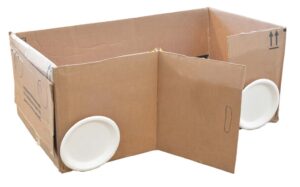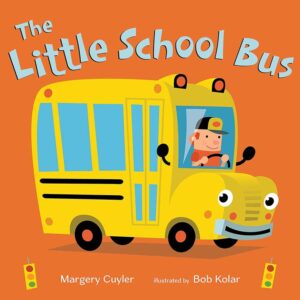Social interaction skills
Toddlers pretend they are taking a bus trip that involves stops at destinations they determine.

3–4 large cardboard boxes


Be Prepared: The cardboard boxes are to serve as imaginary buses. Cut an opening or door on the side of each box to provide access. You may wish to affix small paper plates to the sides of the boxes to represent wheels. Place the boxes in a space where toddlers can easily get in and out of a bus.
 [Invite toddlers to join you for a ride in a bus. Begin the activity with the first 2–3 toddlers who show interest.]
[Invite toddlers to join you for a ride in a bus. Begin the activity with the first 2–3 toddlers who show interest.]
Let’s go somewhere together on a pretend bus! We can pretend these boxes are buses. Do you see the door on this bus? That is how we can get in our bus.
Where would you like to go on our pretend bus trip?
[Encourage ideas from all activity participants. If several ideas are suggested, each could serve as a stop on the bus trip. Use a discussion of multiple stops to promote toddlers’ understanding of sequence. Example: “First we could go to the gym. Next we could go to the swimming pool. Then we can come back to our center.”]
Every bus has a driver. Do you think we should have one driver, or should we take turns driving the bus?
[Help toddlers make a decision. Review the decision. Example: “Grace says she wants to be the driver. Ian would like to be the driver too. We can take turns. Grace can be the driver first, and then it will be Ian’s turn.”]
How can we move our boxes to look like a pretend bus? One idea is to put our boxes in a line (behind one another) to make a long bus.
[Encourage toddlers to offer suggestions for how to create a bus and how many boxes are needed. Toddlers may prefer their own box. In this arrangement, the box is a seat. If there are more toddlers than boxes, you may encourage toddlers to share a box.
Comment on toddlers’ actions with the boxes. Example: “Jade is putting her box behind Phillip’s box. Look, Philip! Jade is pretending to sit behind you on the bus!”
Point out positive instances of collaboration. Example: “Jami, you wanted to sit in the large box and so did Cam. You let Cam sit next to you. That is a good way to play together in riding our pretend bus!”
If bus seats are limited, help toddlers share a box with another toddler. Example: “Amelia, you are in a very big box! You have room for one more person in your box. Would you like to share your box with someone else? You can ask Karly if she’d like to share your box with you by saying ‘You can share with me.’”
Continue the activity for 10–15 minutes. Be sure to include the point(s) of destination. Toddlers may wish to wave at imaginary people outside of the bus as they move along. Give toddlers a clear indication that the bus activity is soon going to end. Example: “We stopped at the gym first, then at the pool second. Now we are driving back to our center!”]
[Briefly describe the play interactions during your gathering. Review actions that led to positive play. Emphasize how toddlers initiated play with a peer. Example: “Jami said to Cam ‘You sit’ when they both wanted to sit in the large box.”]
Pretend play in a group can be challenging for some toddlers. Help toddlers understand the intentions of other children and repeat what toddlers say. Some toddlers may not understand that each box has limited space and might try to squeeze in when the box is full. Provide enough space and materials for the number of toddlers who are participating. You may assign yourself a role as bus or trip director to provide temporary structure to the play if sharing is particularly challenging. Offering explicit guidance for turn-taking and modeling pleasant interactions are strong ways to help toddlers develop social skills.
Extra support
Enrichment
Social interaction skills
Toddlers wash toy vehicles together at a sensory table.


Share

Invite 3–4 toddlers at a time to play at the sensory table. Arrange the vehicles on a tray and invite each toddler to select two vehicles to wash. Add a few drops of tear-free shampoo to create bubbles. Invite toddlers to wash their vehicles in the soap with the sponges. Act as a coach for toddlers who are learning to initiate interactions with peers. Example: “Marcus, you are watching Josiah wash his truck. Would you like to wash a truck next to Marcus? You can say ‘Can I play here?’” Praise toddlers’ efforts and persistence in successful bids for peer attention. Example: “Lydia, you are showing Josie the bubbles on your car. Do you see Lydia’s bubbles, Josie?” Encourage toddlers to imitate each other and to share materials, such as a particular car or truck. Acknowledge and describe positive social interactions. Example: “Marcus wanted the blue truck and Josiah shared the truck! Marcus is happy because he is having a turn with the blue truck.” Draw attention to how toddlers are using their hands, with or without a sponge, to wash a toy vehicle
This activity combines a sensory experience with opportunities for social interaction. Playing side by side with fun materials is a promising way to support peer interactions. Toddlers are likely to talk and show one another their soapy vehicles. Describe each toddler’s actions, emphasizing any observed imitating and turn taking. Example: “Josiah is driving his car under the water. Now Lydia is driving her truck under the water too! Lydia is doing the same as Josiah.” Look for opportunities to comment on how a toddler is using his/her hands to manipulate a sponge or in some other way wash a vehicle.
Extra support
Enrichment
Some toddlers may enjoy additional items to wash in the sensory table. Consider adding items in your room, such as people figures, plates and dishes, toy animals, or toy food items.
Social interaction skills
Toddlers engage in pretend play focused on a bus, with opportunities to assume roles of characters introduced in a prior shared book reading.



Be Prepared: The cardboard boxes are to serve as an imaginary bus. Cut an opening or door on the side of each box to provide access. You may wish to affix small paper plates to the sides of the boxes to represent wheels. Place the boxes in a space where toddlers can easily get in and out of a bus.
 Invite several toddlers to read and act out a story about a school bus. Read the book, talking with toddlers about the pictures and words on each page. At the conclusion of the book, introduce the idea of pretending the boxes are the little school bus from the story. Invite toddlers to compare the characteristics of the cardboard boxes with the pictures of the little school bus in the book. Example: “Look! Our pretend bus has a door, just like the door on the little school bus!”
Invite several toddlers to read and act out a story about a school bus. Read the book, talking with toddlers about the pictures and words on each page. At the conclusion of the book, introduce the idea of pretending the boxes are the little school bus from the story. Invite toddlers to compare the characteristics of the cardboard boxes with the pictures of the little school bus in the book. Example: “Look! Our pretend bus has a door, just like the door on the little school bus!”
Encourage toddlers to explore the pretend bus, including getting in and out and practicing being the driver using the paper plate steering wheel. Invite toddlers to act out the story by playing different characters as they get in and out of the bus. Characters may include a driver, girls and boys riding the bus, and mechanics to fix the bus. Example: “First, let’s pretend someone is the driver, like Bob in our book. The driver can be a boy or a girl. Everyone that wants to be a driver will have a turn!” Encourage each toddler to pretend to be a story character and read selected pages of the book that can be acted out by the characters the toddlers chose. Select pages that reflect toddlers’ interests. Ensure each toddler gets a turn to be a character of his/her choice.
Toddlers will enjoy interacting with the cardboard boxes. Some toddlers may not be ready to pretend to act like a character from the book. The emphasis of this activity is to encourage toddlers to enjoy interacting with each other in positive ways. Acknowledge each type of participation and interaction. Examples: “Ava and Jamal are sitting together in the little school bus! They are pretending to ride to school, like the children ride to school in the story.” “Ava is getting on and off the bus, like the boys and girls in our story!”
Extra support
Enrichment
Materials Needed: 1–2 large cardboard boxes, paper plate to represent steering wheel (optional: books about transportation, toy vehicles, and people figures)
Leave one or two of the boxes available for continued play. You may wish to display books about transportation or provide toy vehicles and people figures nearby. Invite toddlers to think of situations or stories they would like to act out together with the boxes. Encourage toddlers to pretend together.
Materials Needed: The Wheels on the Bus by Annie Kubler, shoeboxes—1 per child, crayons and/or markers
Share the book The Wheels on the Bus by Annie Kubler with a mixed-age gathering of children. Invite older children to discuss the pictures and what the people are doing on the bus. Encourage toddlers to make the sounds of the bus. Example: swish, swish, swish; beep, beep, beep. Infants will enjoy playing with small toys as they listen to the older children. As a follow-up to the book sharing, consider offering small boxes, such as shoeboxes, for toddlers and preschool-age children to use as pretend buses with people figures. Children may enjoy coloring the outside of the boxes.